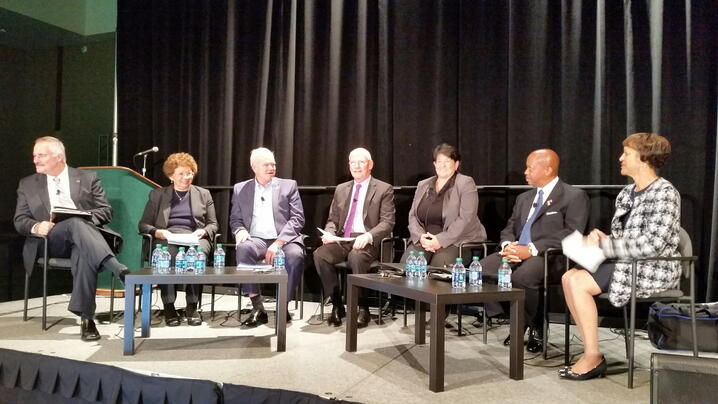
“When is Ferguson going to happen to us?” That’s the question many police departments are asking themselves, and the answer, says Tom Manger, chief of police, Montgomery County, Maryland, is, scarily, “it’s really only one incident away.” But therein lies the opportunity as well. Ferguson and similar incidents can be the catalyst for important dialog among police departments, managers, and the community.
Of course, it’s far more difficult to start building trust after an incident occurs. The key is to build trust through consistently-applied fair and high-quality decisions. The underlying questions are, what are you doing to sustain or build trust, and what policing policies and tactics align the culture and values of your community?
Panelist Susan Manheimer, chief law enforcement official, San Mateo, California, noted that many of the non-major cities are not very skilled in having these kinds of tense conversations. Bottom line: Both the police and managers have to commit to having the conversations.
But in some instances, observed Thomas Bonfield, city manager, Durham, North Carolina, managers have been a little quiet on this topic, leaving the police chief to be the face of the city and creating the perception among police chiefs that they are out there on their own. Managers have to step up to the plate to be transparent, accountable, and proactive.
One way for managers to ensure accountability is to know what’s going on in the police department (e.g., use-of-force policies and policing statistics) long before an incident occurs. As Norton Bonaparte, city manager, Sanford, Florida, describes, the community needs to know the manager is holding the police accountable. And in the case of the Sanford incident, it was what the police did not do that upset the community.
In building trust, elected officials can be champions around these issues and how the city is going to respond. As Antoinette A. Samuel, deputy executive director, National Leagues of Cities, Washington, D.C., put it, it’s about leadership. Elected officials have the unique ability to convene the community, particularly those directly affected by the issues, and to make sure that the stakeholders (businesses, health organizations, faith leadership, etc.) collaborate.
Gloria Rubio-Cortes, president, National Civic League, Denver, Colorado, agrees. It’s about leadership and building relationships now, not waiting for something to happen. Managers have to reach out to not-your-usual suspects and see how the issues look from their perspectives. The good news is that you don’t have to start from scratch. Lots of cities, for instance, have leadership programs, and you can go to them for help. Plus you can develop future leaders from among their youth.
When asked what 21st century policing looks like, Manheimer said you have to make sure policing tactics and strategies do more good than harm. You have to balance all you can do to protect individuals and the community with an acceptable level of force.
Moderator Bob O’Neill, executive director, ICMA, Washington, D.C., made sure to ask the panelists how to have honest conversations about the underlying tension of race relations.
Samuel pointed out that the conversation can’t be limited to only policing. As she noted, at the point that the police get involved, you’re dealing with the results of the situation. The underlying issues are education, health disparities, and more. It’s also important to recognize that communities are different, so the conversations will be different.
As for the manager’s leadership role, Bonfield emphasizes that managers can’t just rely on the police chief. And they have to balance the urgency of immediate problems with the sustainability of long-term solutions. The conversations, Bonaparte noted, can be most successful when they occur in a safe place. In Sanford two pastors took the lead. They secured a theater and invited the community to watch the film Selma and then talk about it afterward. Rubio-Cortes suggested that managers look at libraries as a safe place for tough conversations.
Manheimer reminded the audience that policing is transactional, every day. She gave the example of pastors and church elders riding around with the police and getting out of the police car to talk with residents. That contact between the pastors/elders and the residents profoundly opened the eyes of Manheimer’s officers. It made them realize they’re not the answer—that they need to strategize together to leverage neutral third parties in the community.
Another important element of effective policing has to do with hiring the right people. Manger notes that there’s been a sea change in what qualifies one for the police force. Instead of targeting former military personnel, Manger looks for the person who exhibits empathy and a spirit for public service. And Rubio-Cortes notes that you also have to extend the invitation to people from your community, that is, to invite the full diversity of your community.
Manheimer observed that because you’re only one hiccup away from a horrible incident, you have to have explored the right questions about your community’s policing policies and tactics. You need to understand the level of tolerance of force and awareness of policing in the community. And very importantly, the community needs to hear from the police when good things are happening.
New, Reduced Membership Dues
A new, reduced dues rate is available for CAOs/ACAOs, along with additional discounts for those in smaller communities, has been implemented. Learn more and be sure to join or renew today!
